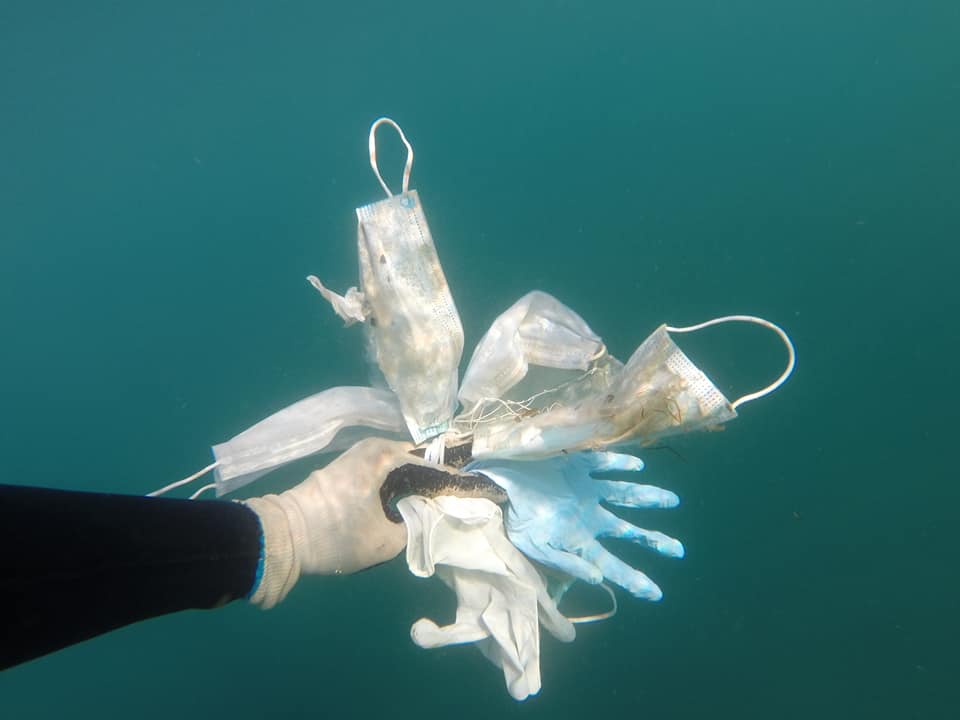The world’s largest cargo plane recently landed in Toronto, delivering 130 tonnes of medical supplies from China, including personal protective equipment (PPE).

The Antonov AN-225 has circled the globe during the COVID-19 pandemic, bringing shipments of equipment to countries crying out for supplies to tackle the novel coronavirus.
PPE is vital to health-care workers as they treat the millions of cases worldwide. Face masks, however, are now commonly used among the general public.
It’s recommended that Canadians wear non-medical face coverings in their everyday lives where physical distancing isn’t possible.
The Public Health Agency of Canada (PHAC) also recommends people use washable masks, made from natural fabrics, rather than surgical masks.
Many people are also using disposable latex or vinyl gloves, although the PHAC says handwashing offers more protection than using gloves.
Even if someone wears gloves, the PHAC adds, they must wash their hands anyway.
As a result, a mountain of single-use masks and gloves is already piling up across the world, and the items can often be seen carelessly discarded on sidewalks and in parking lots.
Although many disposable masks may look like they’re made of paper or natural fabric, they are manufactured using polymers that take decades or centuries to decompose.
A recent study from University College London’s Plastic Waste Innovation Hub said that if every person in the United Kingdom used one single-use face mask each day for a year, it would create 66,000 tonnes of contaminated plastic waste — or about one kilogram per person.
The French NGO Opération Mèr Propre recently released a video of its divers digging fistfuls of PPE out of the Mediterranean Sea off the Côte d’Azur.
“Anything that is thrown into the street can end up in the sea,” said Joko Peltier, co-founder of the organization.
“At first (in the pandemic), we didn’t have much, but little by little — in fact, every time there is rain at the Côte d’Azur — there is more and more waste.”
A doctor’s plastic voyage
U.K.-based doctor Hilary Nash has treated COVID-19 patients at an intensive care unit in Brighton, England.
The Irish medic is acutely aware of the problem of single-use plastics in the oceans.
Earlier this year, just before the pandemic, she volunteered to join a leg of the eXXpedition project, sailing between Panama and the Galapagos Islands.
On each leg, crewmembers gather and analyze ocean plastics to help better understand where the solutions to plastic pollution lie.
“This one particular day that stood out for all of us, we were about two days from land. So no one around us — no boats and people, nothing,” Nash said from her Brighton home.
“For four hours — one afternoon in that day — we had a constant stream of trash just floating past our boat, and big pieces of trash.”
- Ontario First Nation declares state of emergency amid skyrocketing benzene levels
- ‘Sciatica was gone’: hospital performs robot-assisted spinal surgery in Canadian first
- Do Canadians have an appetite for electric vehicles? Experts are divided
- More financial institutes are offering crypto-services, survey shows
Now, Nash sees single-use gloves and masks litter the street on her short walk to work.
“It’s another plague, unfortunately. It’s another plastic plague that we’re facing now,” she said.
“We will always need single-use plastic and disposable items in health care, specifically for infection control. My message was always that so we can continue to do that in health care and protect people from infection, we need to be more mindful about the types of plastics and the types of pointless plastics that we’re using in other aspects of our life.”
The PPE expert
PPE regulatory expert Kim Trautman says people should realize that face masks for the general public are more about protecting others than the wearer.
The former U.S. Army medical co-ordinator is the executive vice-president for Medical Device International Services at the public health regulatory company NSF International.
“So the whole purpose of having people wear masks at this point now, be they do-it-yourself masks or the ones that we can still purchase, are for the purpose of us not spreading the disease,” said Trautman.
She recommends homemade masks for two main reasons: they can be made to better fit your face shape, and the natural fabrics are more breathable for extended use.
The use of even simple homemade bandanas will also free up the medical-grade PPE needed by health professionals.
When it comes to gloves, Trautman thinks some hand covering is better than nothing, but only if the wearer is extremely careful in how they use gloves.
She uses washable garden gloves when shopping for groceries, and she makes sure to remove them safely afterwards, as recommended by agencies like PHAC.
“If you don’t dispose of it (properly), any surface that it touches exposes that particular surface,” said Trautman.
“If you’re having anybody that has to pick up that PPE, that’s not been disposed of properly, then it’s potentially affecting them as well.”
Reusable mask fashion
Montreal fashion designers José St-Jacques and Simon Bélanger saw their business UNTTLD affected by the COVID-19 pandemic and decided to see if there might be a market for face masks as fashion items.
“We basically recycled all the ends of rolls that we have of all the fabrics that we’ve had from previous collections,” said Bélanger.
“We’re proud to say that it’s 100 per cent made here. Our materials are responsible and they’re easily washable and reusable.”
The stylish masks sell online for $50, which might sound pricey, but even more expensive masks are already available from other retailers.
While selling to the affluent and the fashion-conscious, the designers also wanted to do something to help less fortunate women affected by domestic violence and isolation during the lockdown.
Five dollars from the sale of each UNTTLD mask goes directly to the Patricia Mackenzie Pavilion at the city’s Old Brewery Mission.
“Since we dress women, and part of our mission is to empower them, you know, how can you feel empowered if you don’t feel safe?” said St-Jacques.
“Demand has been really insane. Actually, we are trying to keep up with demand, which is amazing.”








Comments